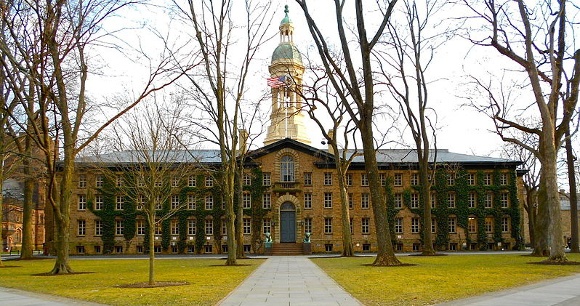Fitzgerald, F Scott Contents
Fitzgerald’s early life
Family background
Parents
 Francis Scott Key Fitzgerald was born on 24 September 1896 at St Paul, Minnesota, in the United States. His family was upper-middle class with connections on his mother’s side to Francis Scott Key (1779-1843), the writer of the lyrics to The Star Spangled Banner (the American national anthem). The choice of the new baby’s name reflected the family’s pride in their heritage, which was mostly in the South:
Francis Scott Key Fitzgerald was born on 24 September 1896 at St Paul, Minnesota, in the United States. His family was upper-middle class with connections on his mother’s side to Francis Scott Key (1779-1843), the writer of the lyrics to The Star Spangled Banner (the American national anthem). The choice of the new baby’s name reflected the family’s pride in their heritage, which was mostly in the South:
- His mother, Mollie (Mary McQuillan 1859-1936), came from a family of Irish immigrants who made their wealth in the grocery business. They exemplified the American ideal that this was a land of opportunity for those prepared to work hard.
- His father, Edward (1853-1931), had a furniture business in St Paul which failed in 1898. He then had a career with Procter and Gamble in New York until he was dismissed in 1908, after which the family returned to St Paul, relying on Molly’s considerable inheritance.
Siblings
F. Scott Fitzgerald had two sisters who died before he was born, Louise (Louisa) (1892-1896) and Mary Ashton (1893-1895). Another sister died shortly after birth in 1900 and his only surviving sister was Annabel (1901-1987).
Social status
Fitzgerald spent much of his childhood in New York and then moved back to St Paul when he was twelve. There were some financial struggles, and he said later that he had felt like a poor boy in a rich world, reflecting his perception that his social status was inferior to that of his peers. He was certainly ambivalent about class, admiring and envying the rich and also criticising them in his writings.
Schooling
Fitzgerald’s early education was in New York, where he attended Holy Angels Convent and then Nardin Academy. When the family moved back to St Paul, he was enrolled at St Paul Academy from September 1908, followed by the Newman School in New Jersey in September 1911.
Key influences at this time were Father Sigourney Fay (1875-1919) and Fay’s friend, the Irish writer, Shane Leslie (1885-1971), whom he met in 1912. Fay encouraged Fitzgerald to write and Leslie was later instrumental in presenting The Romantic Egoist to his own publisher, Scribners, in 1918. Initially rejected, after revisions were made it was finally accepted and published in 1920 as This Side of Paradise. Fitzgerald dedicated his second novel, The Beautiful and Damned (1921) to Leslie, ‘in appreciation of much literary help and encouragement’.
Initial literary output
The Mystery of the Raymond Mortgage was the first piece of Fitzgerald’s writing to appear in print, in a 1909 edition of the St Paul Academy’s Now and Then (the school newspaper). He also wrote a play at the age of 14, which was performed in St Paul: The Girl from Lazy J (1910). This was followed by three more for the same company:
- The Captured Shadow
- The Coward
- Assorted Spirits.
University life
Academic progress
Fitzgerald went on from Newman School to Princeton University from 1913, studying English. He later made a scathing comment on the English department, calling it:
 Fitzgerald was notoriously lacking in commitment to his studies, and repeatedly failed to pass a Chemistry course option, which held him back from graduating. He dropped out in November 1915 but returned in September 1916, until finally joining the army in 1917, without completing his degree.
Fitzgerald was notoriously lacking in commitment to his studies, and repeatedly failed to pass a Chemistry course option, which held him back from graduating. He dropped out in November 1915 but returned in September 1916, until finally joining the army in 1917, without completing his degree.
Distractions
Instead of studying, he was heavily involved at Princeton in producing dramatic works. The Triangle Club offered opportunities for writing for the stage, both plays and musicals, and Fitzgerald contributed lyrics for Fie! Fie! Fi-Fi!, The Evil Eye and Safety First. He also wrote poetry and fiction for the Nassau Literary Magazine, edited by his friend John Peale Bishop, and the Princeton Tiger.
Fitzgerald later used Princeton as the basis for his first attempt at a novel, The Romantic Egoist. Whilst there he also became friends with the literary critic Edmund Wilson, who later edited two of his posthumous works.
Initial employment
Against the backdrop of the First World War (1914-18), Fitzgerald joined the army in 1917.After being discharged from the army in February 1919, without seeing active service, Fitzgerald went to work for the Barron Collier advertising agency in New York. He found this boring and unfulfilling work and only stayed for five months.
Meanwhile, Fitzgerald also submitted work for magazines, such as Babes in the Woods, published in The Smart Set in September 1919. His finances were so desperate in Autumn 1919 that he even worked repairing car roofs. With such a precarious income, it is little wonder that his fiancée, Zelda Sayre (see Marriage and parenthood), was reluctant to continue an engagement to someone so financially insecure.
Related material
Scan and go
Scan on your mobile for direct link.